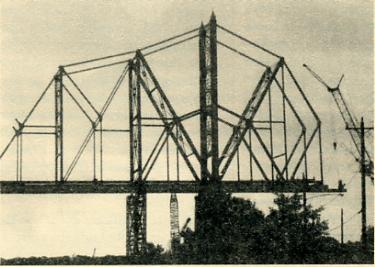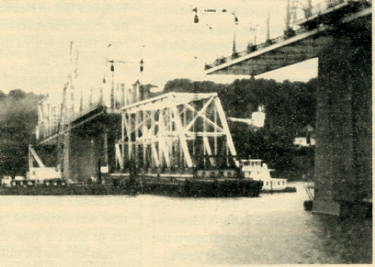
The Blue Bridge comes down.
Click Here to Return to Milestones

This is an article for bridge enthusiasts, however, if you are not one of these, please read on. You may discover that you are more interested than you realized. Someone has remarked that they regretted very much seeing the passing of the "Blue Bridge" because it was "almost as though the bridge had a soul. " Since a bridge is a material thing, made of concrete and steel, it is not likely to have a soul. However, there are countless ways in which this inanimate object has played a significant role in the lives of a great number of people, not only those who designed and built it, but all of those who used it for over half a century.
A good place to begin to demonstrate this relationship between bridge and people, would be to consider the dedication and skill of the designer that is reflected in the appearance of this bridge. This project had to be a major event in his life. What a total fulfillment of a great dream this must have been to see this structure come to completion.
A few hours spent with the design drawings prepared by Mr. T. H. Wilkerson, County Engineer in the late 20's and early 30's, reveal the incredible amount of thought, skill, and work that went into the design of this bridge.
Many people have expressed the opinion through the years, that this bridge has had a beauty that goes far beyond something that is purely utilitarian. This has been very ably related in a poem written at the time of the dedication of the bridge, by Mr. A.W. Anderson of Monaca.
"The Blue Bridge", along with the nearby P.&L.E. Railroad Bridge, has made a very impressive appearance in the valley. One could almost say that they approach being a matched pair, even though built at different times, and for different use. We could say that the "Blue Bridge" is a fancier, more delicate version of the massive railroad bridge. One of the component parts of both bridges is called "lace". In the case of the "Blue Bridge" this lace, while being structurally important, is equally important as an adornment, as lace is meant to be. The bridge was designed and built in a time, when designers believed that a structure should be beautiful as well as useful.
Recalling events that occurred 55 years ago in detail is not always easy, but during the period of the construction of this bridge some details stand out.
The first appearance of something new and different was the arrival of barges and cranes in the river near the Rochester shore. Rows of steel "piling" were driven into the river bed, providing an enclosure from which water and mud were removed. From these "holes" in the river, stone and concrete piers eventually grew.
First steel, orange in color, was placed upon the center pier. This was marred by a tragic accident early in the construction, resulting in the loss of life. As the steel erection proceeded, and the towers on the piers rose to half their height, even at this stage, the size of the new bridge was very impressive, compared to the existing suspension bridge then in use. When the second section was added to the height of the towers, the final height of the project was almost overwhelming to an eleven year old boy. From the walkway, to the top, these towers are 132 feet high, plus another I I feet for the familiar points.
As the construction neared its end, with the erection of the Monaca portal, the skyline of the area was dramatically changed. A new and exciting element had been added to the area, visible from countless points in many surrounding communities. All through the construction period, the sound of riveting guns, and the sight of red hot rivets flying through the air, as they were thrown from the bridge deck to its highest parts, were always present. Today, new bridges are bolted together. Soon the orange color was changed to gray, and a concrete deck and streetcar tracks were added.

Sometime before the completion of these, the writer could wait no longer, and one fine summer day took an initial trip across the bridge. This first crossing was cut short by construction workers, who really didn't need any kids around. Thus it was that I travelled the new bridge before it was opened, and the same "old" bridge after it was closed.
Very soon after the dedication and opening of the new bridge, the old suspension bridge was demolished. The climax of this operation occurred when the final cable was cut in the center and the two tall towers toppled into the river. And now history is being repeated.
The new bridge evoked some rather strange responses from some adventurous people in the early days of its existence. Some of the younger pedestrians crossing the bridge soon learned that by kicking the columnar beams with the toe of one's shoe, a surprising ringing sound could be produced. More than one jump was made from the deck of the bridge into the river on the basis of a dare or a bet, with little ill effect on the jumpers. Small aircraft have at times been flown under the deck of the bridge.
One very lively football pep rally (some claimed that it was a riot) occurred on the middle of the bridge, one evening before the next day's MonacaRochester game. That interrupted the football schedule for several years.
The St. Patrick's Day Flood of '36 brought water more than half way up on the piers. In the early days of WW II, sentry booths were placed at both ends of the bridge to prevent possible sabotage. During WW II, a considerable number of Navy vessels passed under the bridge, accompanied by the repeated blasting of factory whistles, and those of other river craft. These ships had been built at Ambridge, and Neville Island, and were on their way to war.
As an illustration of how people's lives can be very closely tied to some material object, even abridge, I would like to recollect a series of personal situations, where the bridge played a part in most of the significant events of a lifetime.
In the middle and later 30's, when there were very few automobiles compared with the present time, pedestrian traffic on the bridge was quite heavy. A Friday or Saturday evening walk to Rochester for movies or shopping was a common practice. Twenty minute bus service (after the trolleys were discontinued) was also available for five cents. The walk each way was a good setting for sight-seeing, romancing, or serious thinking. Have you ever seen a full moon reflecting on the middle of the Ohio River on a summer (or winter) night?
For two years, in the early part of WW II, the bridge was the route to work from Monaca to the CurtissWright Plant in Beaver. After the war, the route was reversed, and was from New Brighton area to Koppers Co., at the Kobuta Plant.
Two walks across the bridge on separate Christmas mornings are especially recalled. The first was shortly before the war, returning from Rochester at five A. M., after an all night celebration including church services, carolling, parties, and a wind up of going to Rochester for hot dogs. The second time was at six A.M., going to Rochester to meet a ride to work in 1943. When leaving for military service, the first time, the route included the P&LE R.R. bridge, but the returns were by crossing the Blue Bridge.
There followed in 195 1, a three and a half month courtship, which consisted of two crossings every evening, seven times a week. Then the bride was brought over the bridge to stay. Some time later, came two fast crossings on short notice, that added a daughter and a son for the return trips. Then one sunny day in 1955, a truck hauled all of our possessions over the bridge to a new home, after a year of crossings while building it.
The next significant event was the final crossing of the bridge by a ninetyeight year old former Monaca resident, who had lived her last few years in New Brighton. She came very close to out-living two bridges.
The last episode of note involving the bridge in this list of experiences and fond memories, took place five days before the sudden and permanent closing of the bridge. After the wedding of the second daughter, several cars containing all of the close relatives and friends of both families, crossed the bridge on a Saturday evening, bound for the reception at the Turner's in Monaca. The bridge was closed forever the following Thursday afternoon, because it was considered to be in danger of possible imminent collapse. Even pedestrian traffic was temporarily prohibited.
Thus ended almost a lifetime relationship with a bridge, except for one or two more walks across a closed and quiet bridge for photographs. For over fifty years, the bridge stood available for the use of all, whatever the need.
It is now near the end of June 85, and the
Blue Bridge is rapidly disappearing. This will leave a large empty
space in the skyline, that has been filled for a long time. Soon
a new bridge of a totally different design will appear, but the
three high towers, with their unique crowning points, will be
gone forever. It is sincerely hoped that this new bridge will
be as useful, meaningful, enjoyable, and appreciated as the Blue
Bridge has been through the years.